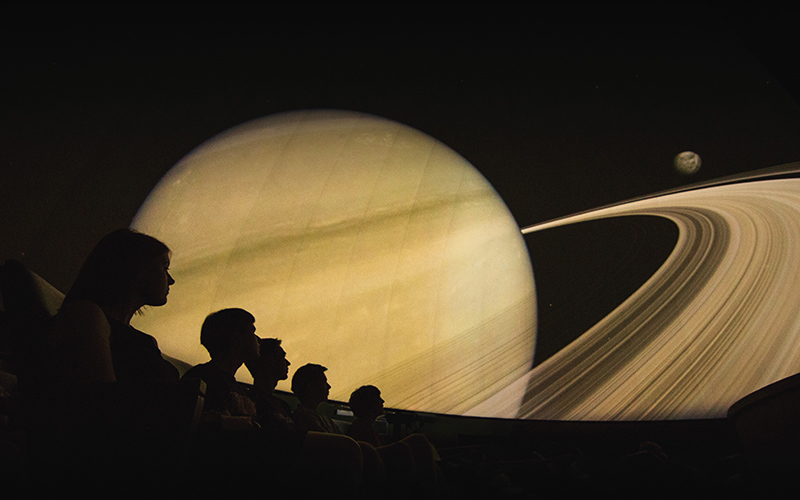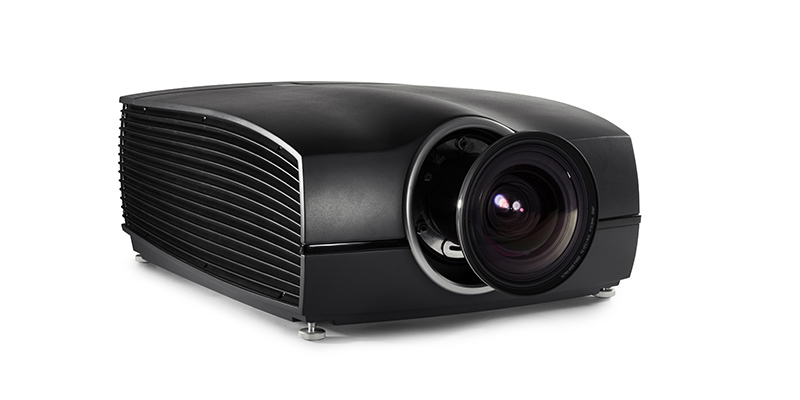One of Sciss’s challenges for this year has been to take a good look at the projector market in order to pick out the very best and high-quality standard projectors for our display configurations. Our engineers have been doing in-house tests at our Stockholm office for some time, and we’ve built up a robust and clear set of configurations that will be released soon.
Monitoring the projection market is something we as system integrators do continuously, and I’d like to share some thoughts with you on the current landscape. It’ll be some history, some present-day reporting, and some thoughts on the future.
The Proven Planetarium Big Shots
In 2009, Projectiondesign (now Barco) introduced a new version of their GP3 projector, the F35 series. Thanks to the high resolution (2,560 x 1,600 pixels for the small form factor), excellent black levels and low total cost of ownership, it instantly became a favorite projector amongst planetariums. The following year JVC announced the DLA-SH7NLG projector (I’ll call it “SH7” from here), again a projector with high resolution and black levels paired with low maintenance cost. This projector also became the preferred choice for many planetariums.
Today, 6-7 years later, a quick and non-scientific look in Loch Ness Production’s Dome Theater Compendium shows the impact these projectors have in our market. I´ve looked at roughly 200 entries (I only browsed entries from Sciss, Evans & Sutherland and Sky-Skan) in the LNP Fulldome Theater Compendium that includes information on the projection systems installed at these sites. 85 of these 200 entries are using F35’s and 46 are using SH7’s. To me, this validates my thoughts that the F35 and SH7 have become standard projectors for their respective segment. F35 is the star of two-channel 3K and multi-channel 4K projection system, and SH7 is the celeb of two-channel 4K projection systems.

Image from the Flandrau Science Center at the University of Arizona, a venue with a Colorspace 4K setup using JVC´s DLA-SH7NLG projectors. Photo credit: Flandrau Science Center & Planetarium
Wishing And Hoping
In 2009, Apple introduced iPhone 3GS, an excellent consumer product that changed the scene and set new standards for smart phones. I’m mentioning this because as a planetarium vendor, the rapid development in consumer technology makes me a little jealous. I’m still wishing and hoping for a projector that will set new standards for the planetarium industry. The problem for the planetarium market is that projection manufacturers aren´t developing projectors made for the complex space that a dome theater is. For new releases we can only cross our fingers that a projector developed for simulation, cinema or a similar market, will fit the requirements of a dome theater.
"For new releases we can only cross our fingers that a projector developed for simulation, cinema or a similar market, will fit the requirements of a dome theater."
We have reviewed several projectors over the last few years. A few have had the image quality we see as a requirement (good colors, brightness and contrast sufficient to replicate the night sky) to set a new standard. But oftentimes the installation limitations of those projectors have been unacceptable. Tilt limitations are, for example, often applied by the manufacturer to protect the lamps from burning out to quickly. This might not be a problem in most markets, but for a dome theater it means that the projector only can be installed in horizontal/flat domes, which of course makes it hard to qualify as a standard projector. Recently though, things have started moving, and there are some new releases that show great promise.

Christie Boxer Series - A Challenger
In 2015 Christie introduced the Boxer series - a high resolution, high brightness projector without tilt or roll limitations or separate cooling requirements. An excellent product in every aspect but contrast. My guess is that the Boxer 4K30 is on its way to become a standard projector for digital domes. This is especially true for dome theaters that focus on content where brightness and color reproduction are more important aspects than contrast – for example for fulldome film playback and alternative, non-astronomy content.
Promising Laser Development
As early as 2012, press releases were circulating, buzzing about giant screen cinemas that were to be equipped with laser-based projectors. In late 2015, the American Museum of Natural History installed an 8K projection system in the Hayden Planetarium featuring Christie laser projectors. Laser light source in a planetarium, finally! Too many years have passed with the promises of laser, ultimate brightness and contrast, and long lasting lightsource lifetime. Unfortunately these Christie projectors aren’t commercially available yet, and would they be, the cost would prevent most planetarium from considering them. This seems to be true for all laser-based projectors so far.
A very attractive alternative to true laser is the laser phosphor projector, where instead of one laser per RGB color, as in a laser projector - one laser creates one color and a phosphor wheel is used to create the other two. Conference room-type projectors have already been around proving the reliability of the technology, and now projectors suitable for planetariums are being released.
Sony and Barco have released laser phosphor models that will be available for installations during 2016. The Sony VPL-GTZ270 projector, with a 4K pixel resolution, a native contrast of 20,000:1, and with 5,000 lumens, looks like a possible new standard projector for two-channel 4K projection. Barco’s F90-4K13 projector seems to be the natural successor to the F35.
Some great things about laser phosphor projectors:
- 20,000 hours of operation without lamp changes – good for total cost of operation
- Adjustable light output – great possibility to achieve dark skies and true colors
- No tilt or roll limitations – easy installation in every planetarium.

The Sony VPL-GTZ270 projector. Photo credit: Sony.

The ©Barco F90-4K13 projector. Photo credit: Barco.
I’m really looking forward see these units in full operation. I feel confident that we will see some of them emerge as new standard projectors the upcoming years. And - hopefully true laser projectors will become a standard choice long before 2023!
What is really important?
We all need to ask ourselves what the real impact of a high-quality display is in a dome theater. When you “go digital” after years of running an optical planetarium, the change is so much more tangible. There are all the new possibilities that the new system brings. But what about the audience, the pure reason that we all exist in this industry - how much do they actually care about resolution, brightness, contrast and overall image quality?

Photo credit: barabild.se.
In a small study we’re now making where we look at planetarium reviews on TripAdvisor’s website, it seems like bad technology (image and audio quality) makes visitors more emotional than good technology. In both "positive" and "negative" comments, content (narrative, storyline, graphics, presenter skills, etc) is the most emotional trigger for the audience. Based on this data, content is very important, and good technology is arguably important to a certain limit. You could further investigate whether this means that there is a line where the technology is so good that it’s ignorable - that it must meet a minimum requirement not to draw negative attention, and when it fulfills this requirement the content/presentation becomes the focus. If such a limit/balance exists, it would be interesting to know where it goes.
As a planetarium vendor, we clearly need to provide well-tested display solutions that will awe your audiences and that we can guarantee are right for the specific purposes that your planetarium has. Of course, we also need to provide the software tools needed to deliver amazing content to the audience. In 2016 we’re releasing clear turnkey standard display solutions along with Uniview 3.0. We have put our effort into the real-time capabilities and presentation tools in Uniview, as well as to make software and hardware play together better than ever, and easier to manage than ever. We will get back to you shortly on these topics, and I hope to see you somewhere soon to discuss display, content and software features.

